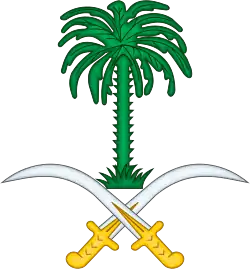Jordan–Saudi Arabia relations
Jordan–Saudi Arabia relations are the relations between the Hashemite Kingdom of Jordan and the Kingdom of Saudi Arabia.
 | |
Jordan |
Saudi Arabia |
|---|---|
Jordan and Saudi Arabia are both Sunni monarchies. Jordan, along with Morocco, the only other non-Persian Gulf monarchy, were invited in May 2011 to join the Gulf Cooperation Council, an organization of monarchies in and around the Persian Gulf.[1]
Historically, the Hashemite dynasty came to Jordan from the Hijaz, now called Saudi Arabia. The Hashemites ruled Mecca from the 10th century until 1924, when the House of Saud annexed the area in the Saudi conquest of Hejaz.

The two cities of Aqaba and Ma'an were part of the Kingdom of Hejaz (1916–1925). In May 1925, Ibn Saud gave up the Aqaba and Ma’an districts of the Hejaz and it became part of British Emirate of Transjordan.[2] In 1965, Saudi Arabia and Jordan agreed to trade land, thus finalising the Jordan–Saudi Arabia border. Jordan gained 19 kilometers of land on the Gulf of Aqaba and 6,000 square kilometers of territory in the interior, and 7,000 square kilometers of Jordanian-administered, landlocked territory was ceded to Saudi Arabia.[3]
According to a 2013 Pew global opinion poll, 88% of Jordanians express a favourable view of Saudi Arabia, with 11% expressing an unfavourable view, the most favourable opinion of the KSA in the Middle East.[4]
After the elevation of Mohammed bin Salman to Saudi Crown Prince, relations have deteriorated over Saudi attempts to sideline Jordan in negotiations over the Israeli–Palestinian conflict, Jordan's reluctant support the Saudi position during the 2017–18 Qatar diplomatic crisis and limited involvement in the Saudi-led intervention in Yemen, and growing Jordanian ties with Turkey.[5][6]
Saudi Arabia concluded an agreement with Jordan to provide assistance and support to the educational sector for $50 million.[7]
References
- "GCC welcomes Jordan's request to join the council". Xinhua. Archived from the original on 21 August 2012. Retrieved 15 January 2012.
- http://www.kinghussein.gov.jo/his_transjordan.html
- "International Boundary Study, No. 60 – December 30, 1965, Jordan – Saudi Arabia Boundary" (PDF). US Department of State. Retrieved 30 January 2019.
- Saudi Arabia’s Image Falters among Middle East Neighbors Pew Research Global Attitudes Project
- "Saudi Arabia is Playing Political Hardball, But Jordan Stands in the Way". 20 February 2018.
- "Qatar and Jordan Seek a Broader Consensus in Washington". 21 February 2018.
- "Saudi fund signs Jordanian schools agreement". Arab News. 2019-07-06. Retrieved 2019-07-10.
